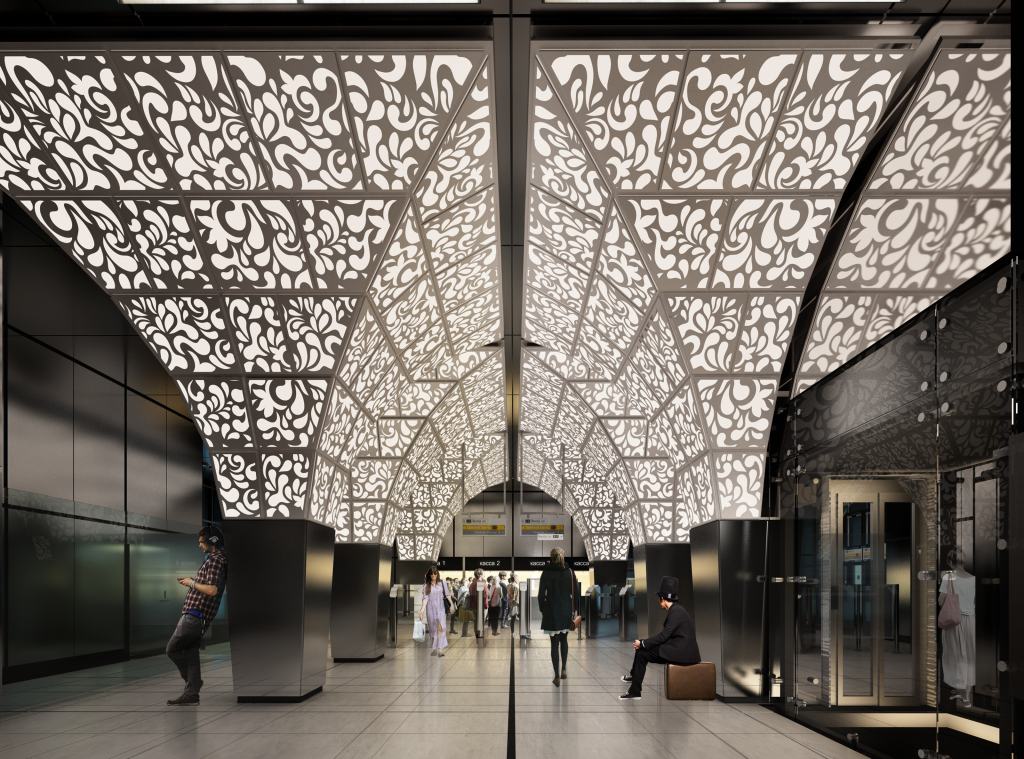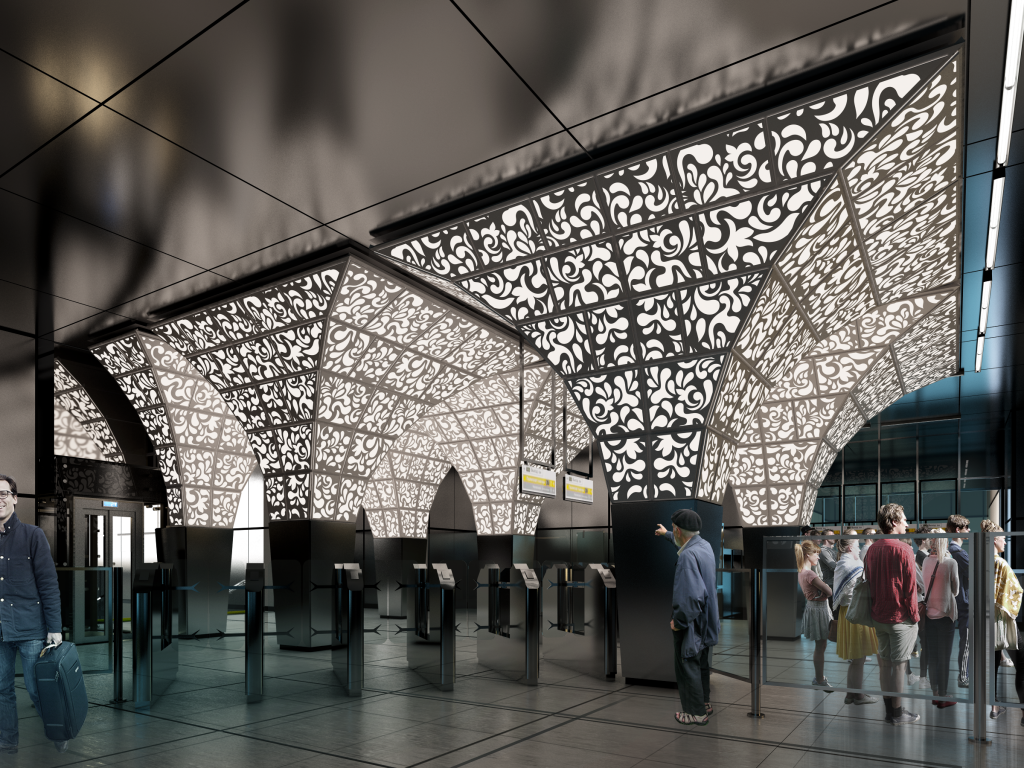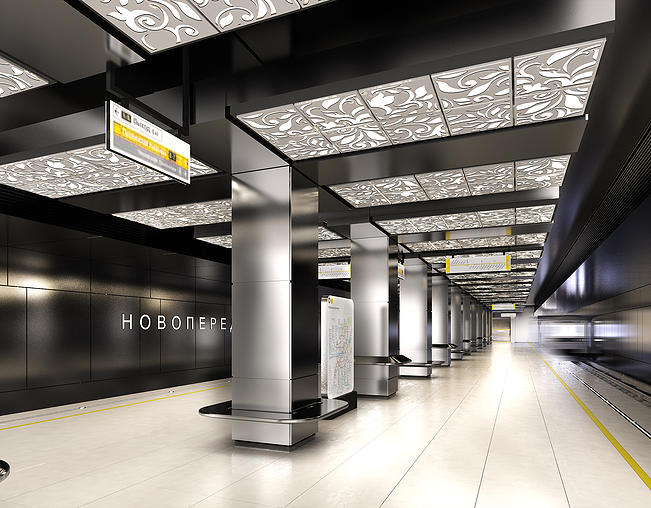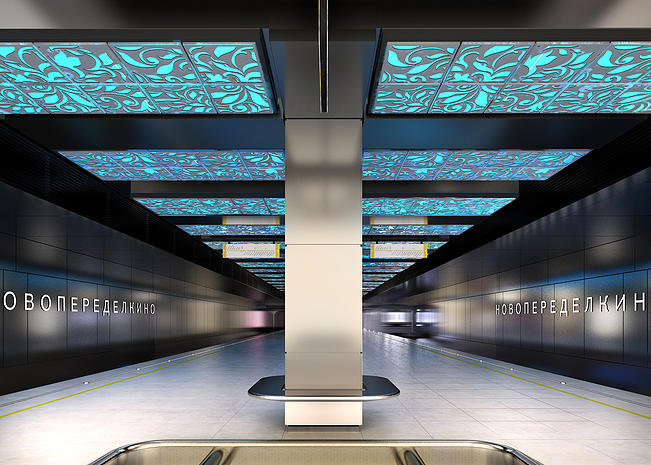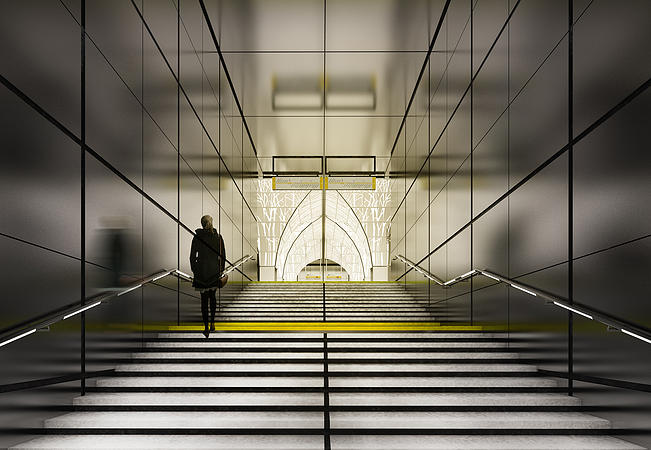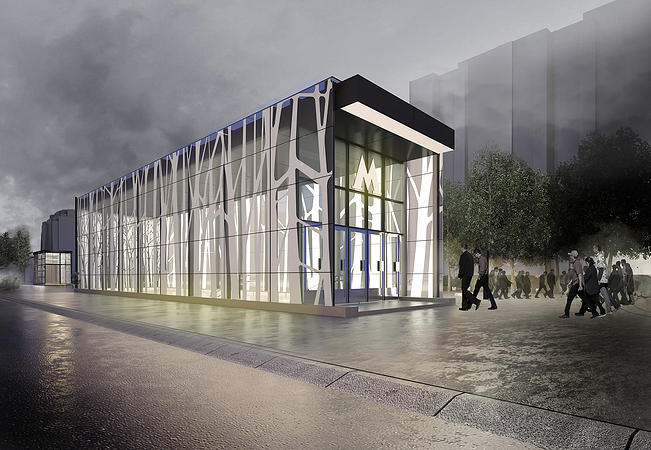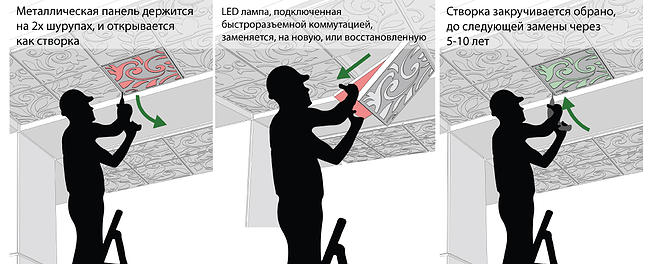МЕТРО НОВОПЕРЕДЕЛКИНО
Spesso commentando lo stato di conservazione, ma anche la qualità architettonica della metropolitana di Milano ci si imbatte nell’eterno fraintendimento che gli allestimenti del 1964, siccome apprezzati in ambito architettonico generino un movimento di tutela e difesa che voglia far si che gli stessi vengano riproposti fedelmente anche per le nuove metropolitane, sia nel presente che nel futuro. Non è questa l’intenzione, uno stile può evolversi e adattarsi non solo per esigenze tecniche e di evoluzione dei materiali, ma anche degli stili e dell’estetica del periodo nel quale vengono concepiti, senza tuttavia abbandonare del tutto alcuni punti chiave che servono a dare unità ad un sistema integrato. Un’unità concettuale degli allestimenti è essa stessa parte integrante del successo di una rete di trasporto, aiutando il passeggero -unico vero protagonista- a muoversi facilmente all’interno di ambienti che impara a conoscere e comprendere. Ecco perché ho selezionato questo progetto per la metropolitana di Mosca; lo studio di architettura lettone U-R-A è riuscito in questo intento in modo ottimale, coniugando lo stile trionfale e monumentale delle stazioni della celeberrima metropolitana russa – forse la prima ad essere considerata come vero e proprio “monumento” degno di visita apposita – rileggendo in chiave contemporanea sia nello stile sia nei materiale e nelle tecnologie. Da notare l’ambiente del mezzanino coperto da grandi volte poggianti su tozzi e bassi pilastri, tipicamente russi, così come la ricchezza del decoro che tuttavia non si rifà a nessun stile antecedente perché basato sul taglio laser di pannelli in acciaio, predisposto informaticamente, e sulla tecnologia LED. Una piccola nota: ancora una volta la stazione è rivestita con pannelli in acciaio che nascondono gli impianti e ne permettono una facile manutenzione, ovvero quel concetto nato a Milano nel 1964. A seguire troverete la presentazione ufficiale del progetto in inglese preceduta da una traduzione in italiano dei punti più salienti.
Moscow to the future: international competition for Novoperedelkino station.
When I speak about the state of the Milan’s subway stations and the it’s architectural quality I will come across the eternal misunderstanding that the project of 1964, appreciated in the architectural world, generate a movement for the protection and defense that wants to ensure that it will be replicated faithfully to the new subways, both at present and in the future. This is not the real intention, a style can evolve and be adapted not only due to technical evolution of materials, but also follow the aesthetics of the time in which they are conceived, without abandoning completely some key points that serve to give unity to the system. So I selected this project for the Moscow underground; the architectural firm URA , from Latvia, created a perfect combination of traditional Russian style and modern material and style. They combined monumental triumphal stations of the famous Russian underground – maybe the first one considered as a real “monument” – in a contemporary project. The main feature is the mezzanine covered with large vaults resting on low pillars as the typical Russian style. The laser cutting steel panels, designed by computer, and the LED technology help to modernize the project. A small note: the station is covered with steel panels that hide the plants and allow easy maintenance, this concept was born in Milan in 1964.
LA STAZIONE NOVOPEREDELKINO
IL CONCEPT ARCHITETTONICO COMMENTATO DAL TEAM LEADER EVGENI LEONOV
L’idea di base è quella di combinare lo stile architettonico di Mosca con la concezione contemporanea dell’architettura di interni e, sopratutto, creare una stazione con un unico e concreto spazio dinamico. Pannelli di metallo, perforati seguendo i tipici disegni russi, contendono l’impianto illuminante e ne diffondono la luce. I disegni creando una durevole e coinvolgente esperienza. La caratteristica principale della stazione è la varietà di sensazioni che induce. Illuminata da RGB LED, sia in piano che in rilievo, possono cambiare schema di colori. Durante le feste cittadine o altri eventi l’illuminazione può diventare blu, rossa o multi colore, oppure trasmettere video. Il quartiere Novoperedelkino è rinomato per la sua foresta ad questa identità è rispecchiata nelle decorazioni delle edicole esterne, tagliate con il laser e completate con vetri decorativi che ricordano la foresta ricca di pini e betulle. L’illuminazione a LED rende i disegni fluorescenti dando l’effetto tridimensionale di una foresta reale. Quindi abbiamo teso a portare avanti lo stile dell’architettura della metropolitana di Mosca, apprezzata negli anni, fino a creare un ‘idea innovata che non fosse solo una copia del passato.
Le edicole a copertura delle scale e il vano ascensore per persone con mobilità ridotta
Le edicole esterne sono realizzate con lastre di acciaio su cui sono intelaiate lastre di vetro.. Questa soluzione è stata usata in molte nuove stazioni di Mosca come Zhulebino e Alma-Atinskaya, ma anche all’estero come Benimamet a Valencia, e molte altre. La copertura è nascosta dietro i pannelli di vetro. Le edicole esterne ricordano i tronchi degli alberi; Novoperdelkino è celebre per la foresta di pini e betulle, così noi abbiamo inteso rendere il disegno dei pannelli come una sorta di simbolo per il quartiere. Questo disegno è chiuso con tripli vetri opachi illuminati sul retro da luci al LED in modo da renderle fluorescenti. Il disegno che riproduce le betulle fa di una normale edicola un oggetto unico e significativo per la città Abbiamo proposto l’uso del pattern degli alberi anche per altri spazi nel quartiere.
Corridoio di accesso e mezzanino
Il soffitto dei corridoi è formato da copri illuminanti piatti coperti da pannelli forati in alluminio e la luce è garantita da un impianto a LED RGB realizzato dalla Società Optogan con il supporto del fondo per l’innovazione Rosnano. I pannelli con LED integrati sono rivestiti con una protezione in plastica trasparente resistente al fuoco e possono essere facilmente sostituiti sebbene pensati per durare almeno 10 anni, garantendo protezione anche dalla polvere. I pannelli contengono infatti un filare di luci LED poste in modo da illuminare una superficie plastica riflettente posta al di sopra, questo evita la formazione di strati di polvere e facilita la sostituzione dei LED. Grazie ai pannelli in alluminio perforato e i colori modificabili dei filtri in plastica, i pannelli LED sono in grado di creare un ambiente suggestivo. I pannelli delle pareti sono realizzate in acciaio lucido al fine di riflettere la luce dei LED e i colori ad essi assegnati durante i vari eventi. Corrimano paralleli a doppia altezza, per adulti e bambini, sono progettati con metallo chirurgico con superficie antibatterica.
Area dei tornelli e delle scale
Nell’area del mezzanino dedicata ai tornelli il soffitto, così come i corpi illuminati, prendono la tipica forma arcuata delle sale delle case russe. Le volte creano una galleria, un passaggio visuale, che aiuta l’utente a raggiungere la direzione desiderata. La parte alta delle volte è brillante e ricca di suggestioni decorative, mentre il livello più basso e maggiormente funzionale e fruibile. La posizione dei corpi illuminanti ricordando delle volte riescono ad aumentare il volume dell’ambiente rendendolo apparentemente più ampio. Il soffitto sembra quindi più alto rispetto ai reali 560cm. La luce quindi, aiuta a rendere l’ambiente più ambio, ma allo stesso tempo, più accogliente. Anche in quest’area della stazione i colori delle luci possono essere facilmente modificati.
Le banchine
Nella seconda fase del concorso, abbiamo pensato di illuminare il vano delle banchine con i medesimi corpi illuminanti piatti del mezzanino e dei corridoi, per semplificare i volumi. Le pareti e il restante soffitto sono coperti don pannelli in acciaio lucido. La combinazione tra l’illuminazione e il materiale dei pannelli crea un effetto simile alla luce del polo nord. Allo stesso modo i riflessi garantiti dall’acciaio non infastidiscono il manovratore e sono spesso usati per allestire l’interno delle stazioni delle metropolitane. Schermi antincendio e di estrazione dei fumi sono posizionati tra e sopra i corpi illuminanti con sportelli dedicati all’accesso agli impianti integrati lungo la parete di pannelli rendendo gli stessi non visibili (Milano docet!). Ogni colonna supporta sia delle panche sia dei supporti che permettono di appoggiarsi.
L’illuminazione
L’idea del sistema di illuminazione prende origine da quello progettato per la stazione HafenCity della metropolitana di Amburgo, la quale è dotato di una sequenza di volumi illuminati appesi sopra la banchina. Questi volumi sono realizzati con pannelli di acciaio e materiali trasparente e contengono 280 RGB LED. Lo schema dei colori può variare al momento dell’arrivo del treno o del clima seguendo le stagioni, i momenti del giorno o anche l’umore del capo stazione. Per la stazione Novoperedelkino abbiamo pensato di sostituire i volumi appesi con corpi illuminanti scatolari e installarli in modo da formare un soffitto.
La variabilità è il nostro concetto base. L’RGB LED permette di cambiare lo schema di colore facilmente per creare modificando, apparentemente, lo stile della stazione. In occasione di festività cittadine i colori della stazione potranno essere in tema. L’utenza potrà sarà contenta nel vedere tante possibilità cromatiche. Inoltre i colori potranno essere cambiati lentamente durante tutto l’arco della giornata, dai toni più vivaci per la mattina fino ai toni tenui per la sera. Tutti i colori coincidino con le principali regole sanitarie e per l’esatta percezione dello spazio durante il cammino; tutte le combinazioni includono sempre il bianco. Tutto ciò prevede che le varie combinazioni di colore vengano realizzate solo da tecnici esperti. La terapia del colore è ritenuta un valido supporto alle terapie mediche tradizionali. La nostra stazione sarà in linea con questo metodo e aiuterà a migliorare l’umore dei passeggeri usando i vari schemi di colore. Le luci LED sono ritenute migliori per gli occhi umani, rispetto a quelle al neon correntemente usate nella metropolitana di Mosca. La luce LED ha molti vantaggi fra i quali: nessuna vibrazione, maggiore brillantezza del colore (Ra > 80%), ad un’alta efficienza nei consumi.
Gli ornamenti
Intendiamo continuare la tradizione artistica negli allestimenti decorativi della metropolitana di Mosca scegliendo dei pannelli perforati con disegni ornamentali. Il cliente potrà scegliere tre opzioni ornamentali: Betulla, Subway e Khokhloma. Nella fase esecutiva del progetto il cliente potrà uno solo dei tre temi o combinarli tra loro:
Ornamento Betulla: il distretto di Novoperedelkino è stato sempre famoso per il suo unico micro-clima generato dalle foreste che lo circondano. In questa area di Mosca le essenze dominanti sono la betulla, il pino e l’abete rosso. Vicino alla città di Moskovsky si può trovare uno dei più antichi boschi di betulla, la quale, insieme al pino, può essere visto come una vera componente identitaria. Per la quartieri della grande città e i suoi sobborghi, che sono spesso anonimi, avere un’identità è di primaria importanza. Noi abbiamo sviluppato un taglio dei pannelli in gradi di riprodurre le foglie, i tronchi e i cespugli apposta per questo progetto.
Ornamento Subway: quando questo tema è stato sviluppato la nostra intenzione era quella di creare una decorazione basata sul logo della Metropolitana di Mosca. Partendo da quest’ultimo abbiamo proposto una decorazione che ne variasse lo stile, dal popolare al più astratto. Queste decorazioni sono facilmente percettibili: visti da lontano appaiono come un unico pattern mentre ci si avvicina si trasformano in una sequenza di “M”. Questo motivo può essere usato sia nella stazione sia come elemento decorativo per materiale stampato o altre necessità dell’azienda.
Ornamento Khokhloma (Decorazione russa): la decorazione usata nella fase preliminare del concorso è facilmente collegabile a quelle tipiche del folklore russo, i motivi dell’architettura dell’antica Russia e degli antichi palazzi di Mosca. Noi crediamo che questo pattern possa essere molto popolare. Esso è composto da motivi raffiguranti fili d’erba, Zhar-Ptitsa (uccello di fuoco), campane e molti altri.
Segnaletica
Il progetto ripropone il sistema di segnaletica sviluppato dall’amministrazione di Mosca. Il sistema è basato sull’idea che il trasporto cittadino è un unico organismo composto da elementi correlati tra loro. Le linee grafiche servono a rendere evidente il percorso e a trovare la destinazione o spostarsi tra stazioni, se necessario. Così come lo schema delle uscite facilità l’utente nel trovare quale scala sia più utile per raggiungere la sua destinazione. Questa stazione può anche essere dotato di un percorso tattile per non vedenti.
U-R-A UNITED RIGA ARCHITECTS:
U-R-A è stato fondato da Yevgeny Leonov e Aleksandr Dembo nel 2013 con lo scopo di unire alcuni architetti di Riga per partecipare ai concorsi internazionali. La combinazione di giovani architetti talentuosi e designer di lunga esperienza uniti con alcuni rinomati architetti lettoni è diventata un successo già dal primo anno, vincendo numerosi concorsi internazionali e prestigiosi premi nell’ambito dell’architettura e del design.
Studio di architetta: U-R-A United Riga Architects
Project manager: Evgeni Leonov, Alex Dembo
Collaboratori: Gulnara Hasanshima, Liva Banka
Disegnatori: Maria Cipisheva, Lina Planinska
Illuminotecnici: Eduard Zhegalin, Alexei Zvjagin, Alezander Astapenkovm, Damil Salikov
Designer: Ivan Galitsa
Luogo: Mosca, Russia
Area: 7800 mq
Gestione concorso: Strelka KB
Cliente: MosinzhProekt
_______________________________________________________________________________
U-R-A CHIEF ARCHITECT EVGENI LEONOV COMMENTS ON WINNING THE NOVOPEREDELKINO SUBWAY STATION DESIGN CONTEST.
We are sincerely glad to know that 300,000+ Moscovites have took part in the voting and viewed our work as the best! And what more, we are excited to know that this opinion of citizens was shared by the Contest judges! It is common people that use subway stations, and thus Moscow Mayor Sobyanin’s idea to involve such common people into the decision making process seems really trendy and reasonable.
Our project is truly Moscow-ish and Russian in the style. We implemented the archetypal Moscow motifs into modern materials and state-of-the-art technologies. The key component of the interior is light panels perforated in the Russian-style pattern. These panels are united into light boxes with their contours suggesting of the Kremlin chambers. Upon passing through the pattern, light creates a lace of lights and shadows. And moreover, the colours may be changed! Integrated RGB LED emitters may change colours of the emitting rays and, for the city holidays and other events, the Novoperedelkino station has all the opportunities to become amazingly variable.
What we found most difficult about the Contest was the necessity to handle the already-given standard project. That is why we were especially glad to see a variety and creativity of all projects submitted for the Contest.
We still have a lot of complicated work ahead, since both deadlines and budgets are tight.
We have to express many thanks to the Contest organisers, the Mayor’s office, and the subway administration, for the impeccable arrangement of the Contest.
NOVOPEREDELKINO SUBWAY STATION: ARCHITECTURAL CONCEPT.
The main idea of our concept was to combine the archetypal motifs of the Moscow architecture with modern ways of interior decorations and, moreover, make the station a truly unique and dynamic place.
Metal panels, perforated in the Russian-style pattern, comprise light boxes and disperse light. The patterns create a lasting and expressive experience.
The prime feature of the station is a variety of experiences created. Being equipped with RGB LED emitters, light boxes – either flat or domed – may change their colour scheme. During city holidays and other events, such patterns may become blue, red, or multi-colour or even broadcast videos.
The Novoperedelkino district is renowned for its unique forests and such identity was expressed in the pavilion decorations – laser engravings in the decorative glasses are reminiscent of forests made-up of pines and birches. LED backlighting makes the engravings fluoresce, creating an almost 3D image of a forest around.
Thus, we aimed at supporting time-proven trends of artistic architecture at the Moscow subway, through creating innovative ideas rather than simple copying of old concepts.
Pavilions above stair approaches and elevator pavilions for people with reduced mobility.
The pavilions are constructed of steel frames to which glass panels are attached. Such solution has been applied in mane recent pavilions, such as Zhulebino and Alma-Atinskaya in Moscow, Benimàmet in Valencia, and more. The dual pitch roof is hidden behind glass facades.
The pavilion decorations are reminiscent of tree trunks. Novoperedelkino is famous for its pine forests and birch groves, so we think the suggested pattern would become a symbol of the district’s identity.
The patterns are sandblasted within the 3-layer glass. If backlighted by LED, the glass panels with patterns become fluorescent.
The birch pattern makes a standard pavilion look like a unique and expressive object in the city.
The pattern will also be used in the near vicinity for landscaping purposes.
Under-street passages to vestibules.
Passages are primarily decorated with flat light boxes. Behind perforated aluminium panels, there are RGB LED panels made up of LEDs manufactured by Optogan company which is supported by the Rosnano innovation fund. Integrated LED panels have light-pervious plastic housings (flammability class G1, dust-permeability class P65), could be changed in a couple of minutes, and may work for 10+ years. Since LEDs are directed to the butt end of the light-pervious plastic sheets, while dust might accumulate above the sheet only, such dust would not hinder the light and operation.
Due to their perforated patterns and changing colours, RGB LED panels create soft ambient light with strong emotions.
The station panelling is polished stainless-steel, to reflect patterned light boxes and colourful lighting during city holidays, thus making a celebrative air.
Twin rails – for both adults and children – are designed to be of the surgical metal with anti-bacterial coating.
Ticket hall and elevator/stairs zone.
Light boxes are shaped as Moscow chamber vaults and made of perforated panels. The vaults create the gallery – a visual passage that helps to establish a sense of direction. Upper levels of the interior are bright and imaginative, while lower levels are ultimately functional and convenient for people movement. As light boxes remind of vaults, this expands the hall and makes it look grand. The hall ceiling seems to be much higher than it actually is – 560 cm between the floor and ceiling. Ambient light helps to make the station look warm and spacious. Light boxes may change their colour in every area of the station, being attached to pillars via steel frames. Our lighting designers managed to find a simple and elegant solution for vault lamps – standard line lamps would be installed along the upper and lower contours of the light box only, while the internal white space in the box would reflect and disperse light throughout the box. Thus, it would not be difficult, if needed, to replace several standard lamps of the same line. Open perforations would not hinder passage of dust, which makes cleaning easier.
Platform zone.
At the 2d stage of the Contest, we suggest installing flat light boxes above the platform, to simplify serviceability. The light boxes are made of steel frames and open perforated-steel panels. Since the panels are open, they will not hinder passage of dust and make the panels easier to clean. Inside panels, standard RGB LED line emitters are used. This helps to both achieve better energy efficiency and change colour scheme at the station during city holidays and other events. The station walls and ceiling are panelled with polished stainless steel. The combination of the lighting scheme and panelling materials creates an amazing effect similar to polar lights. Besides, the steel reflections do not hinder train drivers’ vision and are often used for subway station decorations. Antismoke screens and ventilation boxes of the smoke-extraction system are located between and above of light boxes, with doors of cable boards integrated into the wall panelling, thus making the engineering systems not visible. Each pillar has both benches and areas to lean against.
Style-Making Components.
The prime decorative component is the Moscow pattern, to be applied in the light box perforations. Light boxes have varying shapes – flat, crisscross, and domed. Each type of light box is located at a separate zone of the station. The boxes are equipped with RGB LEDs and may change their colour. The boxes are segmented into small opening panels with a RGB LED emitter within. LED lamps have longer service lives and the panel leafs are soft in opening, thus making the station servicing easier.
Lighting Concept.
Our lighting concept had its prototype at the HafenCity station, Hamburg, which has a row of light boxes hanging above the platform. The boxes are made of steel frames and light-pervious panels, with 280 RGB LED emitters in each box. The colour scheme of the station may change, depending on train arrival or environment, such as season, daytime, or even mood of the station manager.
For the Novoperedelkino concept, we suggest replacing hanging containers with patterned light boxes and making them look like vaults. In the under-street passage with much lesser dust contamination, we suggest installing horizontal light boxes made of closed panels.
Variability is a basic idea of our concept. RGB LED allows changing a colour scheme to create varying air at, and appearance of, the station. For city holidays, the station’s colours will be in line with the holiday theme. The visualisations show some sample of such thematic colours – Spring, Spartak the Champion, and New Year. People would be delighted to see such variability. Also, colours may be changed slowly during a day – from active tones in the morning to calm shades in the evening. Moreover, as lighting colours need to comply with sanitary standards and specifics of space perception when moving; and every lighting theme need to include white; this means that colour schemes should be developed by expert professionals.
Colour therapy is a long-standing healing method. Our station will be in line with this traditional method and helps to raise people’s moods by using various colour schemes. The LED lighting is deemed to be better for human eyes that the luminescent one, as is currently used in the Moscow subway. LED advantages are as follows: no flickering, higher colour output (Ra > 80%), and energy efficiency (by several times).
Lighting System Operation.
To simplify serviceability, we arranged light boxes as small panels (60 cm x 60 cm). Panels could be opened as leafs thus making the RGB LED replacement fast and easy. For instance, the under-street passage has 22 light boxes with 198 metal panels and removable RGB LED panels within. An RGB LED emitter’s service life exceeds 50,000 hours. Its takes 5 minutes to change one RGB LED lamp in the lightbox panel. Based on this, we estimate the servicing time for one under-street passage as approximately 6 man-hours per operation year.
RGB LED Lighting Management.
Light boxes are connected to and controlled by the central lighting management system. To control both RGB and White lighting, we suggest using the dedicated software of the Russian origin. The station manager may change the light intensity and theme, using the lighting management software at the personal computer.
The dedicated software supports as follows:
1. Separate lighting management for all station zones – platforms, passages, entrances, etc., at which DMX-controlled lamps will be installed.
2. The lighting scenarios will be in accordance with the operation schedule, which helps to improve energy efficiency of the system.
3. Lighting scenarios could be adjusted for each zone of the station separately, for the entire calendar year, for each holiday and season.
4. Audio reels at the station may be combined with the lighting scenarios, thus creating a unique atmosphere. Such audio support may be either pre-programmed or chosen manually.
Ornament Themes.
We intend to support the artistic trend in the Moscow subway decoration by choosing ornament-perforated panels. The Customer may choose three ornament options (themes), such as Birch Trees, Subway, and Khokhloma. At the Project implementation stage, the Customer may either choose one theme or combine several themes.
Ornament theme: Birch Trees
The Novoperedelkino district has always been famous for its unique micro-climate fostered by surrounding forests. In this area of Moscow, woods are dominated by birch, spruce, and pine. Near Moskovsky town, you may find the unique old birch groves. Birch and pine may be viewed as an identity component there. For a megalopolis’ districts and vicinities, which are sometimes just faceless, an identity is of prime importance. We developed ornaments for the panel perforation – tree leaves, trunks, and brunches – specially for this Project.
Ornament theme: Subway
When developing this theme, we aimed at creating a corporate ornament of the Moscow Subway. Using the Moscow Subway logo, we suggest ornaments of varying style – from folk motifs to abstract ideas. These ornaments are distinctive for their visual perception: from a distance, they look like a single pattern, while at approaching, they turn to a sequence of ‘M’ letters. (‘Metro’ means ‘subway’ in Russian.) These ornaments may be used for both station decorations and other printed materials and become a part of the corporate style.
We developed the ornaments with the Moscow Subway logo for this Project specially.
Ornament theme: Russian Patterns
Patterns used for the 1st stage of the Contest are easily recognizable as those relating to the Russian folklore, decoration themes of the Old-Russia architecture, and Moscow ancient palaces. We believe that patterns like this may be popular, being composed of grass motifs, curls, Zhar-Ptitsa (Fire Bird) feathers, and bells.
Navigation System
We intend to use the transit navigation system developed by the Moscow government. The system is based on the idea that the city transport is a single organism of inter-related components. Line charts serve to clarify the route and find the destination and transfer stations, if needed. The subway chart serves to plan a route and find the destination and transfer stations, if needed. Exit schemes serve to find the destination station and an exit needed. The subway could also have the floor navigation in accordance with the current design. Visually-impaired persons may use the floor navigation based on tactile surfaces of varying grooves.
U-R-A | UNITED RIGA ARCHITECTS. ABOUT US
U-R-A bureau was founded by Yevgeny Leonov and Aleksandr Dembo in 2013, who aimed to unite leading Riga architects for participating in international projects. A unique combination of young talents and experienced designers, plus partnership with leading Latvian architects became a success –in the very first year, we won several international and prestigious awards in the sphere of architecture and industrial design. Our prime areas are architectural concepts, design projects, industrial design, and researches of the parametric and automatic designing in architecture.
Architects: U-R-A | United Riga Architects
Project Managers: Evgeni Leonov, Alex Dembo
Collaborating Architects: Gulnara Hasanshina, Liva Banka
Designers: Maria Cipisheva, Lina Plavinska
Lighting design: Eduard Zhegalin Alexei Zvjagin, Alexander Astapenkov, Danil Salikov
Design specification: Ivan Galitsa,
Location: Moscow, Russia
Project Area: 7800 m2
Organizer: Strelka KB
Client: MosInzhProekt
LINK AL SITO UFFICIALE/LINK TO THE OFFICIAL WEBSITE
© 2015 Minici Giovanni Luca – www.metroricerche.it, la riproduzione di questo post e delle immagini in esso contenuta è consentita solo previo richiesta scritta all’autore.

